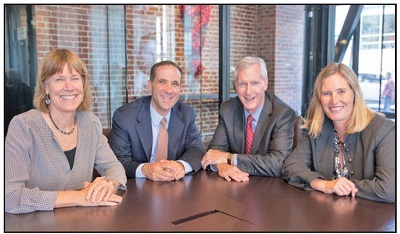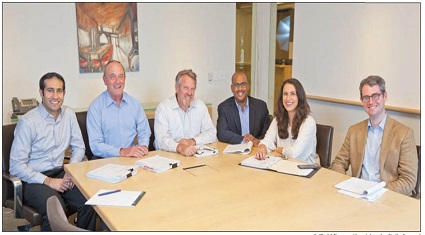
From left: Susan J. Harriman, Michael Celio, Robert Van Nest, Rachael Meny
What these firms offer is value in the form of elite, strategic teams able to solve problems expertly and quickly. Our goal with this inaugural issue was to honor firms that truly embody the meaning: do one thing and do it exceptionally well. We talked to lawyers around the state about the firms they thought stand out. It wasn't long before the cream rose to the top. In conversation after conversation, the same names were mentioned. One named mentioned by virtually everyone we talked to from San Diego to Silicon Valley was Keker & Van Nest. Lawyers at some of the best firms in the state said they model themselves after the San Francisco litigation powerhouse.
Keker & Van Nest has quite a story to tell. The firm started out doing criminal defense, representing counterculture figures and generally raising hell. Over the course of 35 years, the firm has transformed itself first into a high-end white collar defense shop and now a firm that also handles some of the biggest intellectual property, antitrust and securities litigation in the nation. (They still raise hell from time to time.)
"The strength of the pack is the wolf, and the strength of the wolf is the pack."
Star partner Elliot R. Peters recently borrowed this line from Rudyard Kipling's poem, "The Law for the Wolves," to describe the DNA of Keker & Van Nest's success. What Peters meant was that while John W. Keker and Robert A. Van Nest are the undisputed leaders, the potency of the 80-lawyer team behind those two men has and will continue to propel one of the nation's elite litigation boutiques for years to come.
Kipling's lessons on the advantages of the collective were once the building blocks of America's great law firms. The route from associate to senior partner was just down the hall, mentoring was the watchword and rarely were partners kicked to the curb to maximize profits; everyone brought something to the table. Now, true distinctiveness and distinction are increasingly rare.
Then there is Keker & Van Nest.

Paven Malhotra, John Keker, Elliot Peters, Khari Tillery, Michelle Ybarra, Andrew Dawson
The firm has turned down so many offers to merge they say people don't bother to ask anymore. Since its formation in 1978, the firm has hired just two lateral partners: patent litigator Henry Bunsow, who left the firm in 2002 after less than a decade, and Jon B. Streeter, who moved from Orrick, Herrington & Sutcliffe LLP in 1997 and remains today. The rest of the partners grew up at the firm, commonly after serving as a clerk to a federal judge or, in the case of Peters, an assistant U.S. attorney in the Southern District of New York.
"We've never wanted laterals in the sense that a good lateral for other firms is somebody that can bring a large book of business that can put a lot of people to work and can bring the firm more money," Keker said.
Keker & Van Nest is housed in two connecting buildings off Jackson Square in San Francisco and looks more like one of the neighboring art galleries. Exposed brick walls and steel braces, and cubbies and warrens that are the product of haphazard expansion, give the office an air of eccentricity that the partners have embraced. (The conference table in Peters' office is complete with a plush L-shaped bench that looks like a booth in a techie watering hole in SoMa.)
The firm's growth strategy - if one could call it a strategy - is to not get so big as to require a move to one of non-descript high-rises in the Financial District.
The history of the Keker law firm has been told: Keker, a Vietnam War hero, educated at Princeton and Yale Law School, started the firm with law school classmate William A. Brockett Jr. after clerking for U.S. Supreme Court Justice Earl Warren and working as a federal defender in the Northern District. Their first associate was Van Nest, a Chicago native who joined in 1979 after clerking for U.S. District Judge William H. Orrick on the Northern District.
The roster of clients in the early days wasn't the Who's Who of blue chip corporations and industry titans it is today. Instead of modern art, a marijuana poster hung on the lobby wall. Black Panther Eldridge Cleaver was a client. The firm sued the CIA, the DEA and the California prison system. Anything to keep busy, Keker recalled. In the case against the prison, the Keker lawyers didn't know the names of guards they were suing, so the complaint named Goons 110.
"We used to raise hell," Keker said.
While the firm was rooted in the counterculture, the lawyers were never part of that movement. They were well educated, whip-smart and had a clear-eyed view of who and what they wanted to be. They never succumbed to the vices and dubious virtues of their clients.
That fact was hammered home in 1988 when Lawrence Walsh went looking for someone to help him prosecute Col. Oliver North over the Iran-Contra scandal. North's clean image brought much of the nation to an early conclusion that whatever the good soldier might have done in the arms-for-hostages affair was justified in the call of duty.
Nearly 60 percent of Americans held a favorable view of North after the scandal broke, according to a Gallup survey. Keker was the perfect challenger to North. A platoon leader badly injured in battle, Keker carried an air of righteous assuredness that matched North's.
"In time, a good man turned into a bad man. Once lying becomes a habit, it's hard to stop," Keker reportedly told the court.
North was convicted of three felonies and Keker had cemented his reputation as one of the best trial lawyers of his generation.
If the North trial was Keker's introduction to the world, representing Intel Corp. in a long-running dispute with Advanced Micro Devices Inc. over technology sharing was Van Nest's.
Intel hired the Keker firm in the early 1990s after an arbitration that dragged on nearly five years ended with an adverse ruling for the company. By that time, the Keker firm had already handled a trade secrets case for Intel but the ADM case was a bet-the- company case of the type that usually went to larger firms. Van Nest persuaded a Court of Appeal to reverse the award. In a ruling upheld by the California Supreme Court, the appellate court said the arbitrator "exceeded his powers."
"Intel was a huge step up," Keker recalled. "Once we could say we represent Intel, a lot of people in the Valley thought, if Intel hires them we can trust them."
Around the same time, patent litigation was undergoing a transformation that turned it into the juggernaut it remains today. Until then, patent disputes were commonly heard by judges, but plaintiffs realized they might reap larger rewards if jurors were introduced into the mix. This left companies searching for skilled trial lawyers instead of the patent specialists they normally hired.
"That's what we were selling and that's what they were buying," Keker said.
Over the past 20 years, the Keker firm has become so closely linked to patent litigation that it sometimes is labeled an intellectual property law firm and Keker and Van Nest are often listed among the nation's best IP litigators.
Van Nest, in particular, has been involved in some of the most consequential patent trials. He represented Google Inc. in the patent and copyright infringement case against Oracle Corp. over smartphones that is one of the biggest intellectual property cases of this decade.
He said he has gravitated to those cases because he enjoys learning about cutting-edge technology and translating it to jurors and judges.
Keker & Van Nest is still called on to defend many high profile figures in criminal matters: cyclist Lance Armstrong in the drug scandal; Andrew Fastow of Enron Corp.; Frank Quattrone, a New York investment banker; and Bruce Karatz, the CEO of KB Home. Keker is still lead counsel on most of those matters but a new guard of partners is assuming major roles.
Peters - who is widely thought of as the next major leader of the firm - led the defenses of Armstrong, whom prosecutors never charged, and Karatz, who was convicted of stock options backdating but got home detention. Jan Little helped lead the defense of Fastow. Little also represents William Stover, the chief financial officer of Solyndra, the solar company that found itself in the middle of a national scandal when it went bankrupt after receiving a federal loan guarantee.
Susan Harriman, another partner regarded as one of the firm's second wave of leaders, successfully defended Electronic Arts Inc. against copyright claims over its Madden NFL games. Little credits Keker and Van Nest with encouraging their partners' successes.
"John and Bob are very unique," she said, "but they've also cultivated lawyers here who are very unique."
Behind that second string are an equally potent third and fourth string of younger partners and senior associates who have taken on major roles in national litigation, firm leaders say. Asked to name the star junior partners and senior associates, Keker and Van Nest run down a list too long to print, but it is clear that they aren't padding the ranks. As they call out each name, they mention major matters in which that lawyer played a key role.
Partner Ashok Ramani and associate Sharif E. Jacob tried a major case for Netflix Inc. before the International Trade Commission last year. Ramani, a patent specialist with 15 trials under his belt, said client surveys commonly remark on the talent and experience of Keker's younger lawyers.
"Our model has always been learning by doing," Ramani said.
.jpg)
From left: Ashok Ramani, Christa Anderson, Jan Nielsen Little, Jeff Chanin
Partner Daniel Purcell has played significant roles in major matters since he joined the firm in 1999, including the Oracle-Google trial and the no-poach antitrust case. Purcell, who clerked for federal Judge David F. Levi on the Eastern District and was an associate at Heller Ehrman LLP, said it was a very different experience arriving at Keker and being handed big matters.
"I don't think it was a vote of confidence in me particularly but just the way the firm worked," Purcell said.
What has kept him at Keker, Purcell said, is the variety of criminal and civil cases on which he's worked. Attorneys are not pigeonholed into a practice, he said. The only common thread, Purcell said, "is that the cases are all high-stakes."
"The pack is pretty strong," Peters said.